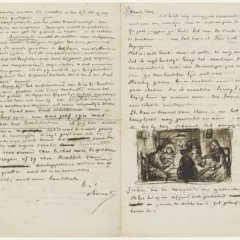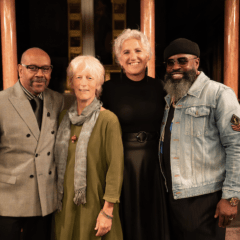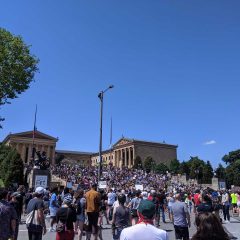This week’s Weekly has my review of the Frida Kahlo show with mention of Lee Miller, also at the PMA, and a note about additional programming in the corridor on the way to the Miller show. For more on the shows see Libby’s post and Andrea’s post.
Frida Kahlo’s works reflect her revolutionary spirit.

Frida Kahlo, The Broken Column/La columna rota, 1944, (Museo Dolores Olmedo, Xochimilco, Mexico City) © 2007 Banco de México Diego Rivera & Frida Kahlo Museums Trust. Av. Cinco de Mayo No. 2, Col. Centro, Del. Cuauhtémoc, 06059, México D.F.
Since feminists rediscovered her in the ’60s, Frida Kahlo’s iconic self-portraits have been part of our cultural landscape. Fridamania—fueled by the artist’s roller-coaster life of sexual adventure, physical pain, emotional injury and triumph through art—has spawned books, movies, fashion fads and websites (2.4 million entries come up on a Google search of the artist’s name). The Kahlo centenary show at the Philadelphia Museum of Art lets you get close to the images that are as familiar as Warhol’s Jackies and Marilyns—and oddly similar in their depiction of figures touched by tragedy.
Kahlo lived with a damaged body and pain from childhood polio and a streetcar accident that almost killed her at 18. She died in 1954, only 47 years old.
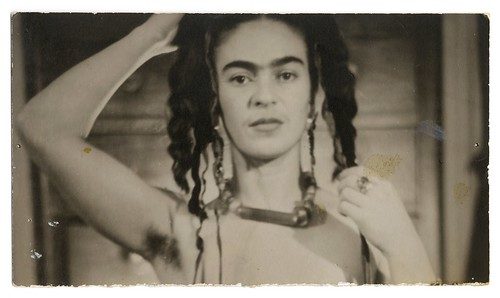
Kahlo’s fiery spirit helped her succeed in spite of herself. She married muralist Diego Rivera, traveled the world, sold her art to museums and collectors (the Museum of Modern Art bought a piece from her New York debut show), and included among her friends and lovers celebrated artists and thinkers like Isamu Noguchi and the Russian revolutionary Leon Trotsky. Her tumultuous open marriage to Rivera survived numerous affairs by both partners, including Diego’s seduction of Frida’s younger sister Christina.
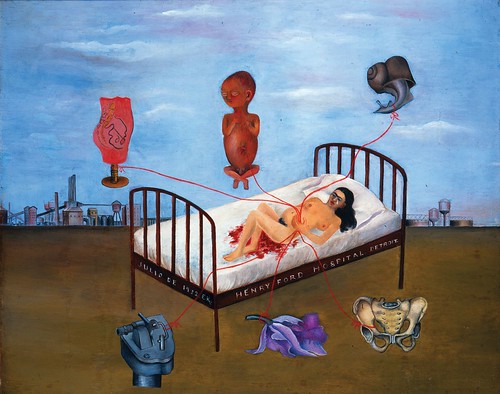
Retablo-like painting after her miscarriage in Detroit.
Frida Kahlo, Henry Ford Hospital, 1932. Oil on metal, 12-13/16 x 15-13/16 inches.
Collection Museo Dolores Olmedo Patiño, Mexico City © 2007 Banco de México Diego Rivera & Frida Kahlo Museums Trust. Av. Cinco de Mayo No. 2, Col. Centro, Del. Cuauhtémoc 06059, México, D.F.
Kahlo’s autobiographical works bare her scars. When she miscarried in Detroit in 1932 she created a highly symbolic and bloody painting in response. After Rivera’s affair with Christina, she painted two angry depictions of a suicide and a murder.
Kahlo’s paintings—begun as therapy when she was recovering from the streetcar accident—show she was no Sunday afternoon daubist. Her works exhibit the power and vision of a fully developed artistic sensibility. Influenced by Mexican folk and religious art and by the dark humor and magical realism of Mexican culture, Kahlo’s portraits transcend the national, and are vital to any discussion of surrealism and self-portraiture.
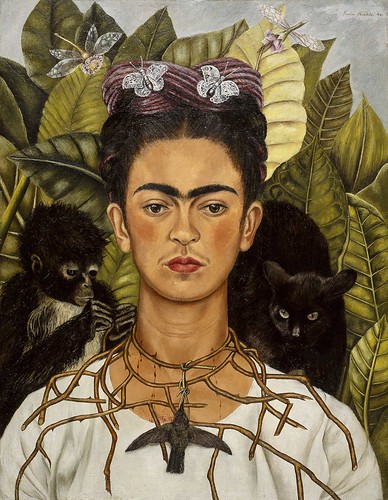
Frida Kahlo, Self-Portrait with Thorn Necklace and Hummingbird/Autorretrato con collar de espinas y colibrí, 1940, 24-1/2 x 19 inches. (Nickolas Muray Collection, Harry Ransom Humanities Research Center, The University of Texas at Austin)
© 2007 Banco de México Diego Rivera & Frida Kahlo Museums Trust. Av. Cinco de Mayo No. 2, Col. Centro, Del. Cuauhtémoc, 06059, México D.F.
It’s fitting that the exhibit thrusts deep into photo documentation of the artist. Kahlo biographer Hayden Herrera (who co-curates the exhibit) said in her talk at the Free Library last month that Kahlo was once thought of as a mere niche artist. No longer marginalized, Kahlo now sits at the table with Picasso, Duchamp and others whose work grows larger and more significant with time.
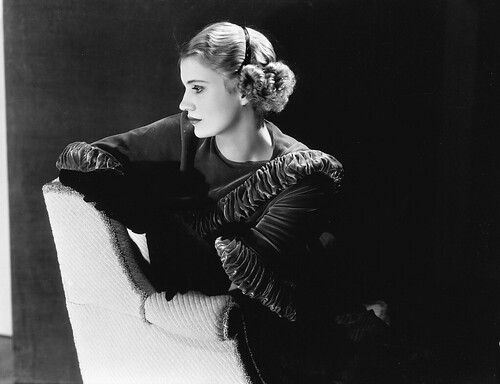
Lee Miller. Self Portrait in Headband, New York, 1932 © Lee Miller Archives, England 2008. All rights reserved.
Also having a centenary exhibit at the PMA is Vogue model turned photographer Lee Miller. And while their art is hardly alike, the two artists have a lot in common, including the year of their birth. They traveled in the same circles in New York and Paris, and both showed at Manhattan’s Julian Levy Gallery. Miller—whose works are like ice to Kahlo’s fire—ran a commercial photo studio where her clients included movie stars and society names. But her best works are her self-portraits, and her humble, snapshot-like photos of what she knew best and loved most—family, friends and the places she lived.
And furthermore
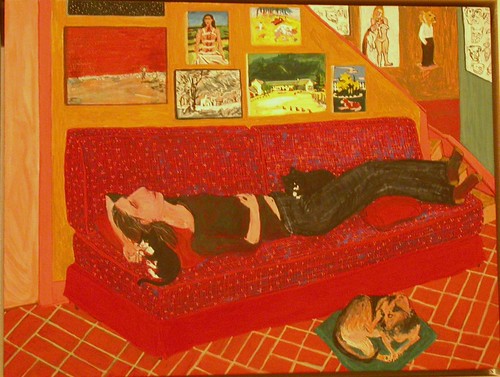
Sarah McEneaney painting on view at the PMA right now has reverberation with Kahlo’s show.
The route to the Miller exhibit (which is in the Berman galleries opposite the gift shop) includes a large first floor corridor under the curatorship of Modern and Contemporary department. The large corridor is usually full of people moving through on their way to or from the gift shop, cafeteria or education department. But the programming is never just a throw-away. The curators use the space to showcase new purchases or to key off the special exhibitions. On view now is a terrific painting by local autobiographical painter Sarah McEneaney that shows the artist resting on a couch, her dog and cats curled around her (like Frida Kahlo’s pet monkeys who wrap their arms around her in her self portraits). McEneaney once told me that the painting (on loan from a private collection) is a dream of the many artworks she’d love to own — including Kahlo’s Broken Column! Also in the corridor right now are works by contemporaries or near contemporaries of both Miller and Kahlo: Beauford Delaney, Horace Pippin, Milton Avery, Alice Neel, William H. Johnson and Jacob Lawrence. Woman artists and artists of color or one who walked to his own drumbeat (Avery), the artists’ works reverberate with the two centenary shows. Paintings by contemporary artist Odili Donald Odita and 60s artist Bob Thompson are counterpoints. Paintings come and go in this changing installation (unlike in some galleries at the museum in which permanent displays reside), and it’s always worth slowing down to consider what’s on the walls.
“Frida Kahlo”
Through May 18. $10-$20. Philadelphia Museum of Art, 26th St. and the Pkwy. 215.763.8100.



